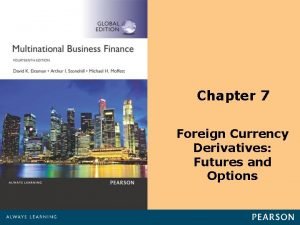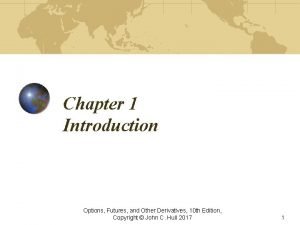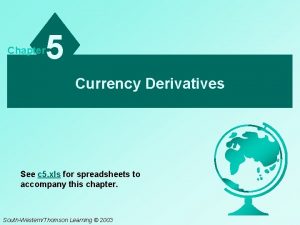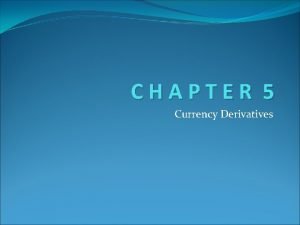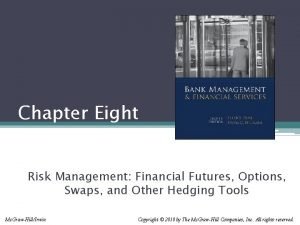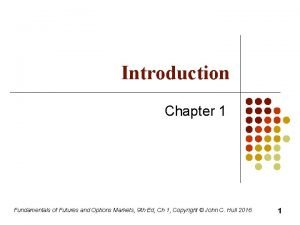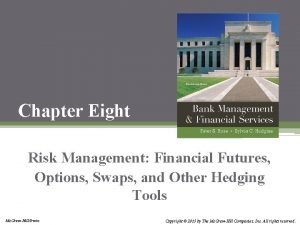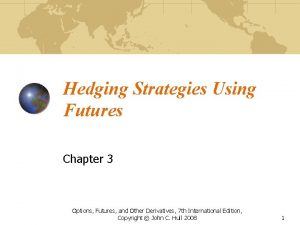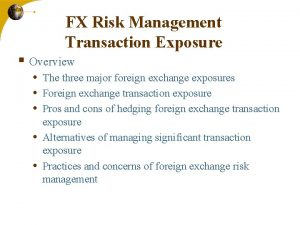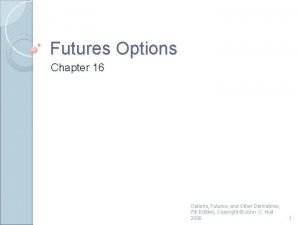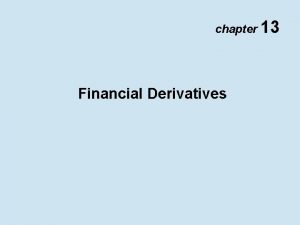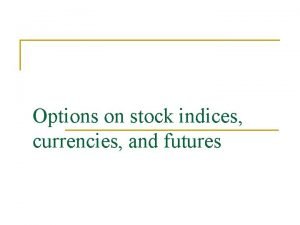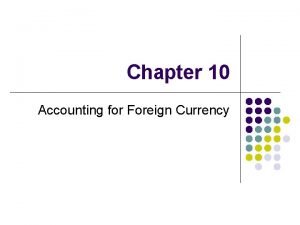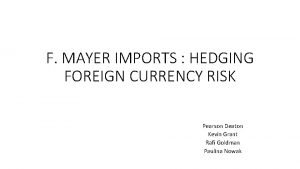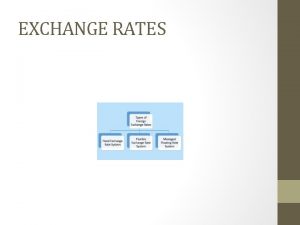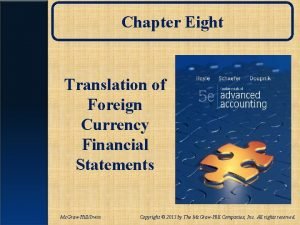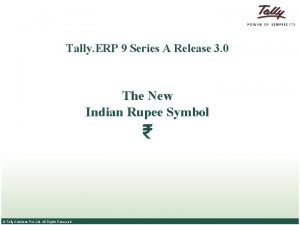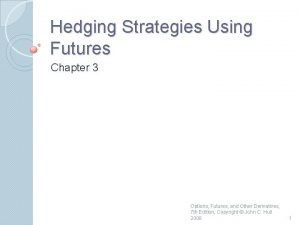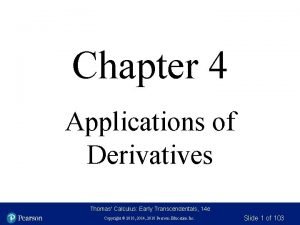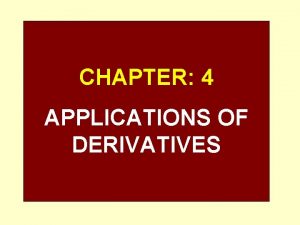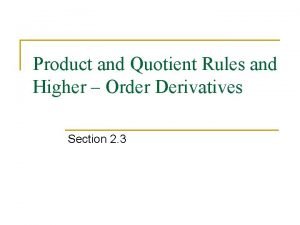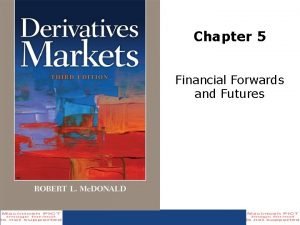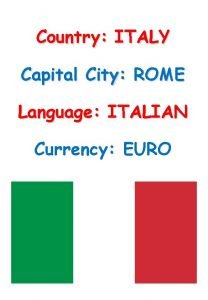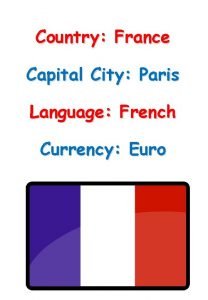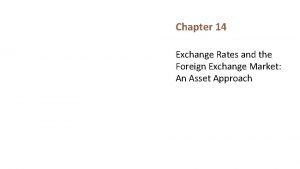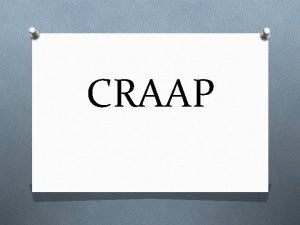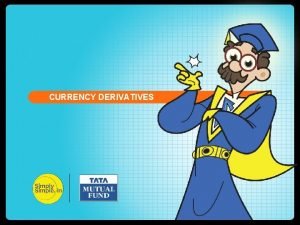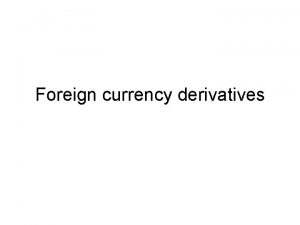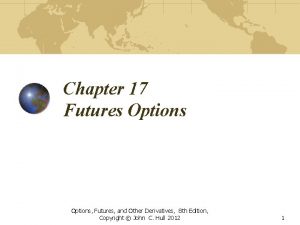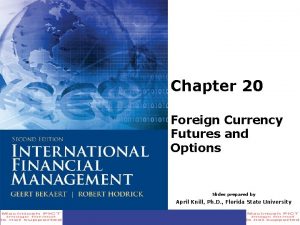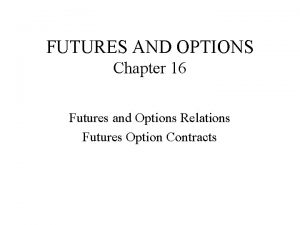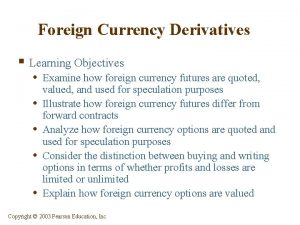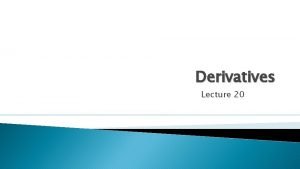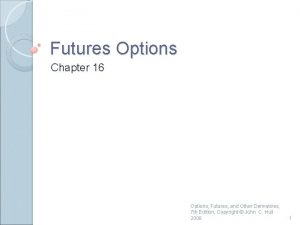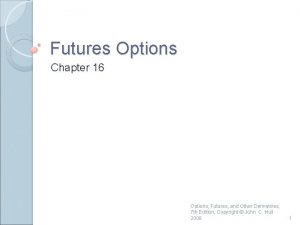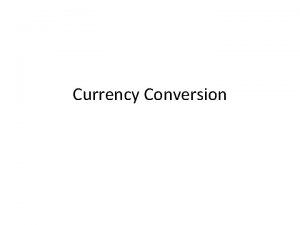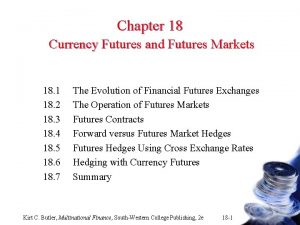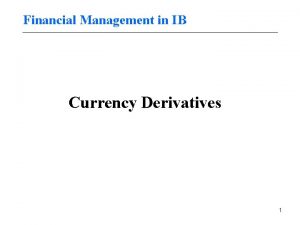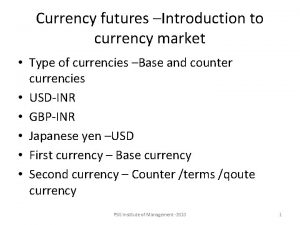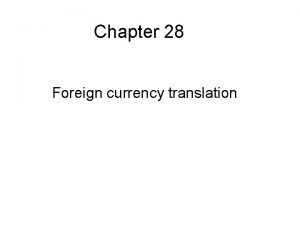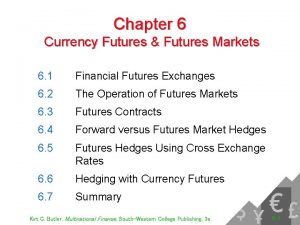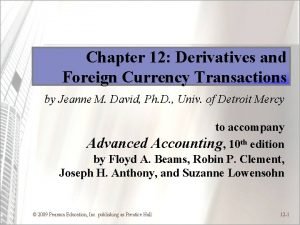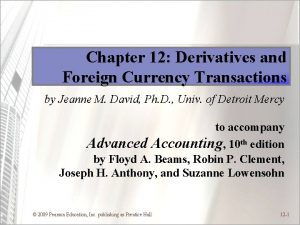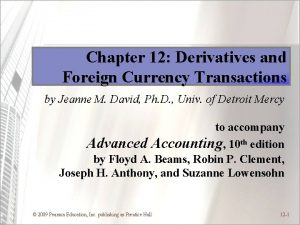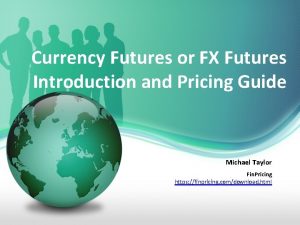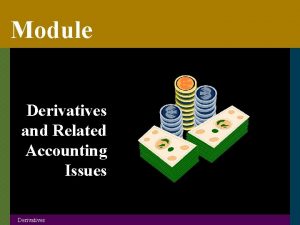Chapter 7 Foreign Currency Derivatives Futures and Options




























- Slides: 28

Chapter 7 Foreign Currency Derivatives: Futures and Options

Learning Objectives • Explain how foreign currency futures are quoted, valued, and used for speculation purposes • Explore the buying and writing of foreign currency options in terms of risk and return • Examine how foreign currency option values change with exchange rate movements and over time • Analyze how foreign currency option values change with price component changes 7 -2 © 2016 Pearson Education, Ltd. All rights reserved.

Foreign Currency Derivatives and Swaps • Financial management of the MNE in the 21 st century involves financial derivatives. • These derivatives, so named because their values are derived from underlying assets, are a powerful tool used in business today. • These instruments can be used for two very distinct management objectives: – Speculation: use of derivative instruments to take a position in the expectation of a profit – Hedging: use of derivative instruments to reduce the risks associated with the everyday management of corporate cash flow 7 -3 © 2016 Pearson Education, Ltd. All rights reserved.

Foreign Currency Derivatives • Derivatives are used by firms to achieve one of more of the following individual benefits: – Permit firms to achieve payoffs that they would not be able to achieve without derivatives, or could achieve only at greater cost – Hedge risks that otherwise would not be possible to hedge – Make underlying markets more efficient – Reduce volatility of stock returns – Minimize earnings volatility – Reduce tax liabilities – Motivate management (agency theory effect) 7 -4 © 2016 Pearson Education, Ltd. All rights reserved.

Foreign Currency Futures • A foreign currency futures contract is an alternative to a forward contract that calls for future delivery of a standard amount of foreign exchange at a fixed time, place and price. • It is similar to futures contracts that exist for commodities such as cattle, lumber, interestbearing deposits, gold, etc. • In the U. S. , the most important market foreign currency futures is the International Monetary Market (IMM), a division of the Chicago Mercantile Exchange. 7 -5 © 2016 Pearson Education, Ltd. All rights reserved.

Foreign Currency Futures • Contract specifications are established by the exchange on which futures are traded. • Major features that are standardized are: – – – – Contract size Method of stating exchange rates Maturity date Last trading day Collateral and maintenance margins Settlement Commissions Use of a clearinghouse as a counterparty • Exhibit 7. 1 provides a description of futures contracts for the Mexican peso 7 -6 © 2016 Pearson Education, Ltd. All rights reserved.

Exhibit 7. 1 Mexican Peso (CME) (MXN 500, 000; $ per 10 MXN) 7 -7 © 2016 Pearson Education, Ltd. All rights reserved.

Foreign Currency Futures • Foreign currency futures contracts differ from forward contracts in a number of important ways: – Futures are standardized in terms of size while forwards can be customized – Futures have fixed maturities while forwards can have any maturity (both typically have maturities of one year or less) – Trading on futures occurs on organized exchanges while forwards are traded between individuals and banks – Futures have an initial margin that is market to market on a daily basis while only a bank relationship is needed for a forward – Futures are rarely delivered upon (settled) while forwards are normally delivered upon (settled) 7 -8 © 2016 Pearson Education, Ltd. All rights reserved.

Foreign Currency Options • A foreign currency option is a contract giving the option purchaser (the buyer) the right, but not the obligation, to buy or sell a given amount of foreign exchange at a fixed price per unit for a specified time period (until the maturity date). • There are two basic types of options, puts and calls. – A call is an option to buy foreign currency – A put is an option to sell foreign currency 7 -9 © 2016 Pearson Education, Ltd. All rights reserved.

Foreign Currency Options • The buyer of an option is termed the holder, while the seller of the option is referred to as the writer or grantor. • Every option has three different price elements: – The exercise or strike price: the exchange rate at which the foreign currency can be purchased (call) or sold (put) – The premium: the cost, price, value of the option – The underlying or actual spot exchange rate in the market 7 -10 © 2016 Pearson Education, Ltd. All rights reserved.

Foreign Currency Options • An American option gives the buyer the right to exercise the option at any time between the date of writing and the expiration or maturity date. • A European option can be exercised only on its expiration date, not before. • The premium, or option price, is the cost of the option. 7 -11 © 2016 Pearson Education, Ltd. All rights reserved.

Foreign Currency Options • An option whose exercise price is the same as the spot price of the underlying currency is said to be at-the-money (ATM). • An option that would be profitable, excluding the cost of the premium, if exercised immediately is said to be in-the-money (ITM). • An option that would not be profitable, again excluding the cost of the premium, if exercised immediately is referred to as out-of-the money (OTM). 7 -12 © 2016 Pearson Education, Ltd. All rights reserved.

Foreign Currency Options • In the past three decades, the use of foreign currency options as a hedging tool and for speculative purposes has blossomed into a major foreign exchange activity. • Options on the over-the-counter (OTC) market can be tailored to the specific needs of the firm but can expose the firm to counterparty risk. • Options on organized exchanges are standardized, but counterparty risk is substantially reduced. 7 -13 © 2016 Pearson Education, Ltd. All rights reserved.

Buyer of a Call Option • Buyer of an option only exercises his/her rights if the option is profitable. • In the case of a call option, as the spot price of the underlying currency moves up, the holder has the possibility of unlimited profit. 7 -14 © 2016 Pearson Education, Ltd. All rights reserved.

Foreign Currency Speculation • Speculating in the options market – If Hans were to speculate in the options market, his viewpoint would determine what type of option to buy or sell – As a buyer of a call option, Hans purchases the August call on francs at a strike price of 58 ½ ($0. 5850/Sfr) and a premium of 0. 50 or $0. 0050/Sfr – At spot rates below the strike price, Hans would not exercise his option because he could purchase francs cheaper on the spot market than via his call option 8 -15 © 2012 Pearson Education, Inc. All rights reserved.

Foreign Currency Speculation • Speculating in the options market – Hans’ only loss would be limited to the cost of the option, or the premium ($0. 0050/Sfr) – At all spot rates above the strike of 58 ½ Hans would exercise the option, paying only the strike price for each Swiss franc • If the franc were at 59 ½, Hans would exercise his options buying Swiss francs at 58 ½ instead of 59 ½ 8 -16 © 2012 Pearson Education, Inc. All rights reserved.

Foreign Currency Speculation • Speculating in the options market – Hans could then sell his Swiss francs on the spot market at 59 ½ for a profit Profit = Spot rate – (Strike price + Premium) = $0. 595/Sfr – ($0. 585/Sfr + $0. 005/Sfr) = $. 005/Sfr 8 -17 © 2012 Pearson Education, Inc. All rights reserved.

Foreign Currency Speculation • Speculating in the options market – Hans could also wait to see if the Swiss franc appreciates more, this is the value to the holder of a call option – limited loss, unlimited upside – Hans’ break-even price can also be calculated by combining the premium cost of $0. 005/Sfr with the cost of exercising the option, $0. 585/Sfr • This matched the proceeds from exercising the option at a price of $0. 590/Sfr 8 -18 © 2012 Pearson Education, Inc. All rights reserved.

Exhibit 7. 3 Profit and Loss for the Buyer of a Call Option 7 -19 © 2016 Pearson Education, Ltd. All rights reserved.

Option Market Speculation • Writer of a call (see Exhibit 7. 4): – What the holder, or buyer of an option loses, the writer gains – The maximum profit that the writer of the call option can make is limited to the premium – If the writer wrote the option naked, that is without owning the currency, the writer would now have to buy the currency at the spot and take the loss delivering at the strike price – The amount of such a loss is unlimited and increases as the underlying currency rises – Even if the writer already owns the currency, the writer will experience an opportunity loss 7 -20 © 2016 Pearson Education, Ltd. All rights reserved.

Exhibit 7. 4 Profit and Loss for the Writer of a Call Option 7 -21 © 2016 Pearson Education, Ltd. All rights reserved.

Foreign Currency Speculation • Speculating in the options market – The payout on writing a call option would be Profit = Premium – (Spot rate - Strike price) = $0. 005/Sfr – ($0. 595/Sfr + $0. 585/Sfr) = - $0. 005/Sfr 8 -22 © 2012 Pearson Education, Inc. All rights reserved.

Option Market Speculation • Buyer of a Put (see Exhibit 7. 5): – The basic terms of this example are similar to those just illustrated with the call – The buyer of a put option, however, wants to be able to sell the underlying currency at the exercise price when the market price of that currency drops (not rises as in the case of the call option) – If the spot price drops to $0. 575/SF, the buyer of the put will deliver francs to the writer and receive $0. 585/SF – At any exchange rate above the strike price of 58. 5, the buyer of the put would not exercise the option, and would lose only the $0. 05/SF premium – The buyer of a put (like the buyer of the call) can never lose more than the premium paid up front 7 -23 © 2016 Pearson Education, Ltd. All rights reserved.

Exhibit 7. 5 Profit and Loss for the Buyer of a Put Option 7 -24 © 2016 Pearson Education, Ltd. All rights reserved.

Foreign Currency Speculation • Speculating in the options market – The payout on buying a put option would be Profit = Strike price – (Spot rate + Premium) = $0. 585/Sfr – ($0. 575/Sfr + $0. 005/Sfr) = $0. 005/Sfr 8 -25 © 2012 Pearson Education, Inc. All rights reserved.

Option Market Speculation • Seller (writer) of a put (see Exhibit 7. 6): – In this case, if the spot price of francs drops below 58. 5 cents per franc, the option will be exercised – Below a price of 58. 5 cents per franc, the writer will lose more than the premium received from writing the option (falling below break-even) – If the spot price is above $0. 585/SF, the option will not be exercised and the option writer will pocket the entire premium 7 -26 © 2016 Pearson Education, Ltd. All rights reserved.

Exhibit 7. 6 Profit and Loss for the Writer of a Put Option 7 -27 © 2016 Pearson Education, Ltd. All rights reserved.

Foreign Currency Speculation • Speculating in the options market – The payout on writing a put option would be Profit = Premium – (Strike price - Spot rate) = $0. 005/Sfr – ($0. 585/Sfr + $0. 575/Sfr) = - $0. 005/Sfr 8 -28 © 2012 Pearson Education, Inc. All rights reserved.
 Currency futures and options
Currency futures and options Options, futures, and other derivatives
Options, futures, and other derivatives Currency futures
Currency futures Currency futures contracts sold on an exchange
Currency futures contracts sold on an exchange Options futures and risk management
Options futures and risk management Forward vs option
Forward vs option Traders in financial futures
Traders in financial futures Tailing the hedge
Tailing the hedge Currency derivatives
Currency derivatives Futures style options
Futures style options Advantages and disadvantages of derivatives
Advantages and disadvantages of derivatives Put-call parity
Put-call parity Foreign exchange accounting
Foreign exchange accounting F. mayer imports: hedging foreign currency risk
F. mayer imports: hedging foreign currency risk Foreign currency exchnage
Foreign currency exchnage Financial statements translation
Financial statements translation How to convert foreign currency to indian rupees in tally
How to convert foreign currency to indian rupees in tally Too foreign for home
Too foreign for home Tailing the hedge
Tailing the hedge Chapter 4 applications of derivatives
Chapter 4 applications of derivatives Chapter 4 applications of derivatives
Chapter 4 applications of derivatives Product and quotient rules and higher order derivatives
Product and quotient rules and higher order derivatives Prepaid forward contract formula
Prepaid forward contract formula Italy currency and capital
Italy currency and capital Paris france currency
Paris france currency Appreciation and depreciation of currency
Appreciation and depreciation of currency Example of timeliness news
Example of timeliness news Currency and timeliness
Currency and timeliness Accuracy authority objectivity currency and coverage
Accuracy authority objectivity currency and coverage
